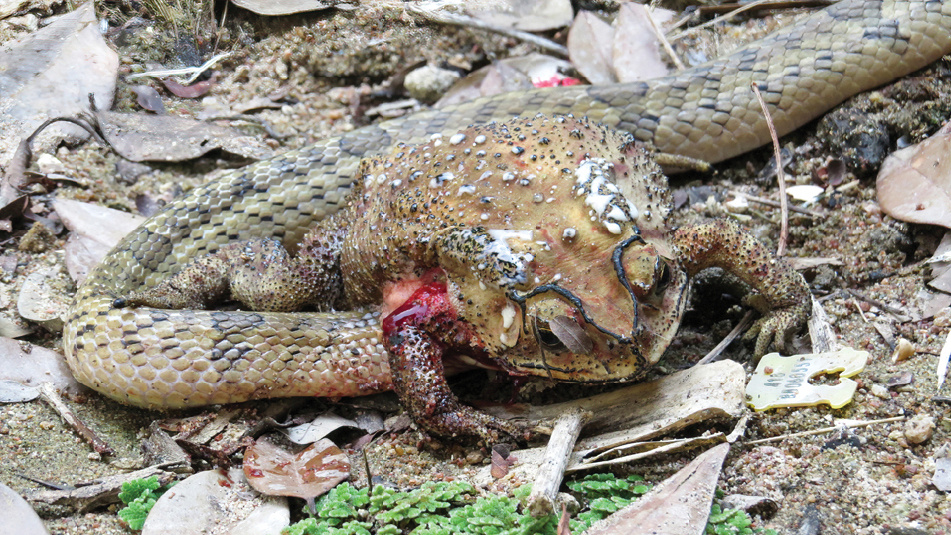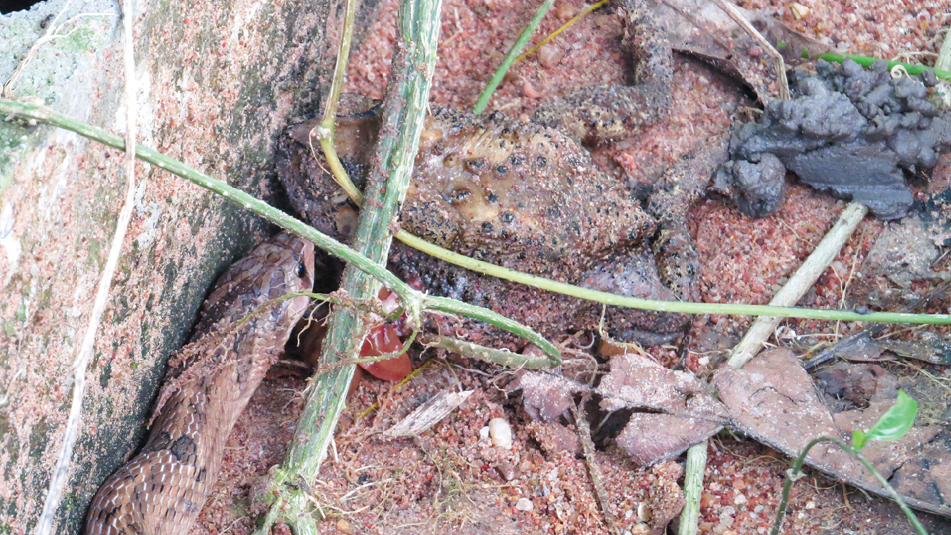Snakes disembowel toads and feast on the living animal's organs one by one
This gruesome behavior was previously unknown in snakes.

Pity the toads that encounter Asian kukri snakes in Thailand. These snakes use enlarged, knifelike teeth in their upper jaws to slash and disembowel toad prey, plunging their heads into the abdominal cavities and feasting on the organs one at a time while the toads are still alive, leaving the rest of the corpse untouched.
While you're recovering from the horror of that sentence, "perhaps you'd be pleased to know that kukri snakes are, thankfully, harmless to humans," amateur herpetologist and naturalist Henrik Bringsøe, lead author in a new study describing the gruesome technique, said in a statement.
This grisly dining habit was previously unknown in snakes; while some rip chunks from their prey, most snakes gulp down their meals whole. Scientists had never before seen a snake Bury its head inside an animal's body to slurp up organs — sometimes taking hours to do so, Bringsøe and his colleagues reported.
Related: Beastly feasts: Amazing photos of animals and their prey
The victims of this horrific organ-slurping were poisonous toads called Duttaphrynus melanostictus, also known as Asian common toads or Asian black-spotted toads; they are stout and thick-skinned, measuring about 2 to 3 inches (57 to 85 millimeters) in length, according to Animal Diversity Web (ADW), a wildlife database maintained by the University of Michigan's Museum of Zoology. During the deadly battle, the toads fought "vigorously" for their lives, with some defensively secreting a toxic white substance, according to the study. The snakes' grisly evisceration strategy could be a way to avoid the toad's poisonous secretions while still enjoying a tasty meal, the researchers wrote.
Kukri snakes in the Oligodon genus are so named because their slashing teeth resemble the kukri, a forward-curving machete from Nepal. While kukri snakes aren't a threat to people, their teeth can cause painful lacerations that bleed heavily, because the snakes secrete an anticoagulant from specialized oral glands, according to the study.
"This secretion, produced by two glands, called Duvernoy's glands and located behind the eyes of the snakes, are likely beneficial while the snakes spend hours extracting toad organs," Bringsøe explained.
Sign up for the Live Science daily newsletter now
Get the world’s most fascinating discoveries delivered straight to your inbox.
Macabre mealtime
The researchers described three observations in Thailand of kukri snakes (Oligodon fasciolatus), which can measure up to 45 inches (115 centimeters) long, consuming Asian common toads. In the first incident, which took place in 2016, the toad was already dead when the witnesses discovered the scene, "but the soil around the two animals was bloody, indicating there had been a fight which eventually killed the toad," the scientists wrote. The snake sawed through the toad's body by swinging its head from side to side; it then slowly inserted its head into the wound "and subsequently it pulled out organs like liver, heart, lung and part of the gastrointestinal tract."
In a second event, an epic battle between a kukri snake and a toad on April 22, 2020 lasted nearly three hours; the snake attacked, withdrew, and attacked again, deterred only temporarily by the toad's poison defense. After finally subduing the toad, the snake extracted and swallowed organs while the toad was still breathing, according to the study.
On June 5, 2020, a kukri snake took a different approach and didn't disembowel the toad at all, instead devouring it whole. But in a fourth observation this year on June 19, the snake eviscerated its toad prey, slicing into the abdomen to reach its organ meal.

Young toads potentially produce less poison than adults do, which may have enabled the snake in the June 5 observation to safely gulp it down in one piece; another possibility is that kukri snakes are immune to the toad species' toxins, but they disembowel adults anyway because the toads are simply too big for them to swallow, the researchers reported.
However, there's not yet enough data to answer these questions, Bringsøe said in the statement.
"We will continue to observe and report on these fascinating snakes in the hope that we will uncover further interesting aspects of their biology," he said.
The findings were published online Sept. 11 in the journal Herpetozoa.
Originally published on Live Science.

Mindy Weisberger is an editor at Scholastic and a former Live Science channel editor and senior writer. She has reported on general science, covering climate change, paleontology, biology and space. Mindy studied film at Columbia University; prior to Live Science she produced, wrote and directed media for the American Museum of Natural History in New York City. Her videos about dinosaurs, astrophysics, biodiversity and evolution appear in museums and science centers worldwide, earning awards such as the CINE Golden Eagle and the Communicator Award of Excellence. Her writing has also appeared in Scientific American, The Washington Post and How It Works Magazine. Her book "Rise of the Zombie Bugs: The Surprising Science of Parasitic Mind Control" will be published in spring 2025 by Johns Hopkins University Press.










